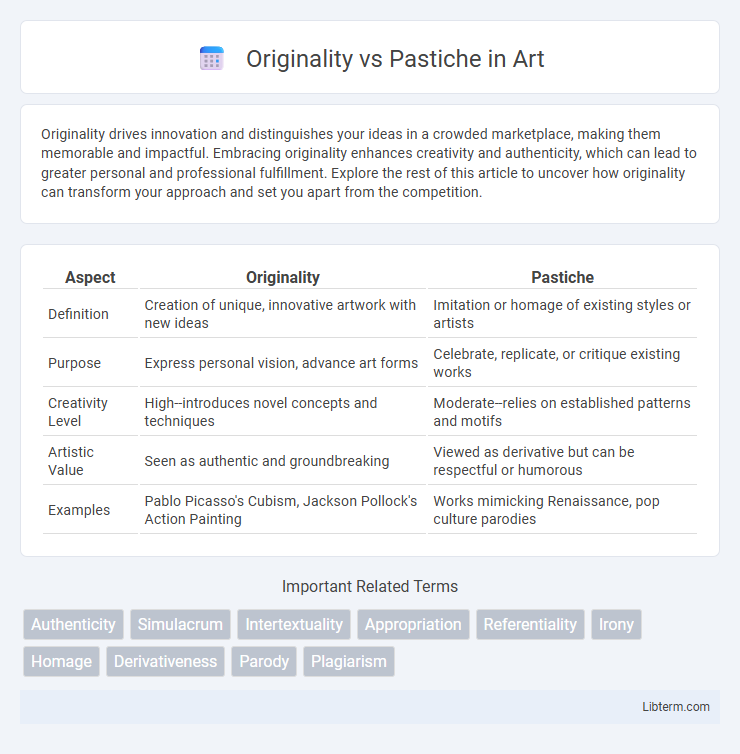Originality drives innovation and distinguishes your ideas in a crowded marketplace, making them memorable and impactful. Embracing originality enhances creativity and authenticity, which can lead to greater personal and professional fulfillment. Explore the rest of this article to uncover how originality can transform your approach and set you apart from the competition.
Table of Comparison
| Aspect | Originality | Pastiche |
|---|---|---|
| Definition | Creation of unique, innovative artwork with new ideas | Imitation or homage of existing styles or artists |
| Purpose | Express personal vision, advance art forms | Celebrate, replicate, or critique existing works |
| Creativity Level | High--introduces novel concepts and techniques | Moderate--relies on established patterns and motifs |
| Artistic Value | Seen as authentic and groundbreaking | Viewed as derivative but can be respectful or humorous |
| Examples | Pablo Picasso's Cubism, Jackson Pollock's Action Painting | Works mimicking Renaissance, pop culture parodies |
Defining Originality in Creative Works
Originality in creative works is defined by the unique expression of ideas that are not directly derived from existing sources, emphasizing innovation and authentic individual perspective. It involves novel combinations of concepts, techniques, or styles that contribute to cultural and artistic advancement. The ability to generate distinctive content distinguishes original works from pastiche, which often imitates or recycles established forms without significant transformation.
Understanding Pastiche: Meaning and Purpose
Pastiche represents a creative work that imitates the style or character of other artists or genres, often as a form of homage or parody. Its purpose is to blend familiar elements with new contexts, allowing audiences to recognize references while enjoying fresh interpretations. Understanding pastiche involves recognizing its role in dialogue with original works, where creativity lies in reassembling influences rather than producing entirely novel content.
Historical Evolution of Originality and Pastiche
The historical evolution of originality reveals its roots in Renaissance humanism, where individual creativity and innovation began to challenge classical imitation, while pastiche emerged as a postmodern aesthetic reflecting fragmented cultural references and intertextuality. Throughout the 18th and 19th centuries, Romanticism further elevated originality as a hallmark of artistic genius, in contrast to pastiche's growing association with eclecticism and homage. In contemporary art and literature, originality is often redefined to accommodate pastiche's collage-like integration of diverse styles, blurring traditional boundaries between authentic creation and derivative reproduction.
Key Differences Between Originality and Pastiche
Originality involves creating unique ideas or works that reflect individual creativity and innovation, while pastiche replicates or imitates existing styles, often combining multiple influences without introducing new elements. Key differences include originality's emphasis on authentic expression and novel content, contrasted with pastiche's reliance on mimicry and homage to familiar forms. Original works drive cultural and artistic evolution, whereas pastiches serve primarily as stylistic references or nostalgic reproductions.
The Role of Context in Judging Originality
The role of context in judging originality is pivotal, as originality often depends on the cultural, historical, and artistic frameworks within which a work is evaluated. In art and literature, what is considered original in one era or society may be viewed as pastiche or homage in another, highlighting the fluidity of creative boundaries. Understanding the surrounding context allows critics and audiences to discern whether a piece introduces novel ideas or merely reinterprets existing conventions.
Pastiche as Homage: Celebration or Imitation?
Pastiche serves as a complex form of homage, blending celebration and imitation by deliberately referencing and replicating styles or motifs from previous works to evoke recognition and nostalgia. This artistic technique highlights the tension between originality and influence, as it honors predecessors while raising questions about creativity and authenticity. Critics often debate whether pastiche revitalizes cultural heritage or merely recycles existing ideas without innovation.
Influences and Inspiration: Navigating Creativity
Originality in creativity emerges from unique synthesis of influences, while pastiche directly imitates existing styles without innovation. Artists navigating creativity balance inspiration drawn from diverse sources with the drive to produce novel expressions. Understanding the distinctions between influence and replication is crucial for fostering authentic artistic development and avoiding derivative work.
Impact of Originality vs Pastiche in Modern Art
Originality in modern art drives innovation by introducing unique perspectives and challenging conventional aesthetics, fostering cultural evolution. Pastiche, while often viewed as derivative, can serve as a critical commentary or homage, blending historical styles to create layered meanings and engage contemporary audiences. The impact of originality versus pastiche shapes artistic discourse, influencing how authenticity and creativity are valued within the art market and critical reception.
Famous Examples: Originality and Pastiche in Literature, Film, and Art
Famous examples of originality in literature include James Joyce's "Ulysses," which revolutionized narrative technique through stream of consciousness, while pastiche is exemplified by works like Jean Rhys's "Wide Sargasso Sea," blending styles to reinterpret classics. In film, Stanley Kubrick's "2001: A Space Odyssey" showcases originality through groundbreaking visual storytelling, whereas Quentin Tarantino's "Kill Bill" employs pastiche by referencing and merging multiple genres and cinematic traditions. In art, Pablo Picasso's Cubism represents a transformative original style, contrasted by postmodern pastiche seen in Jeff Koons's works that replicate and amalgamate historical art motifs.
The Future of Creative Expression: Blending Originality and Pastiche
The future of creative expression lies in the innovative blending of originality and pastiche, where artists merge unique ideas with stylistic references to past works, creating hybrid forms that resonate across diverse audiences. This fusion encourages cultural dialogue and enriches artistic narratives, leveraging intertextuality to push boundaries while honoring tradition. By balancing authentic creativity with reverence for historical influences, creators unlock new dimensions of expression that redefine contemporary art and media landscapes.
Originality Infographic

 libterm.com
libterm.com